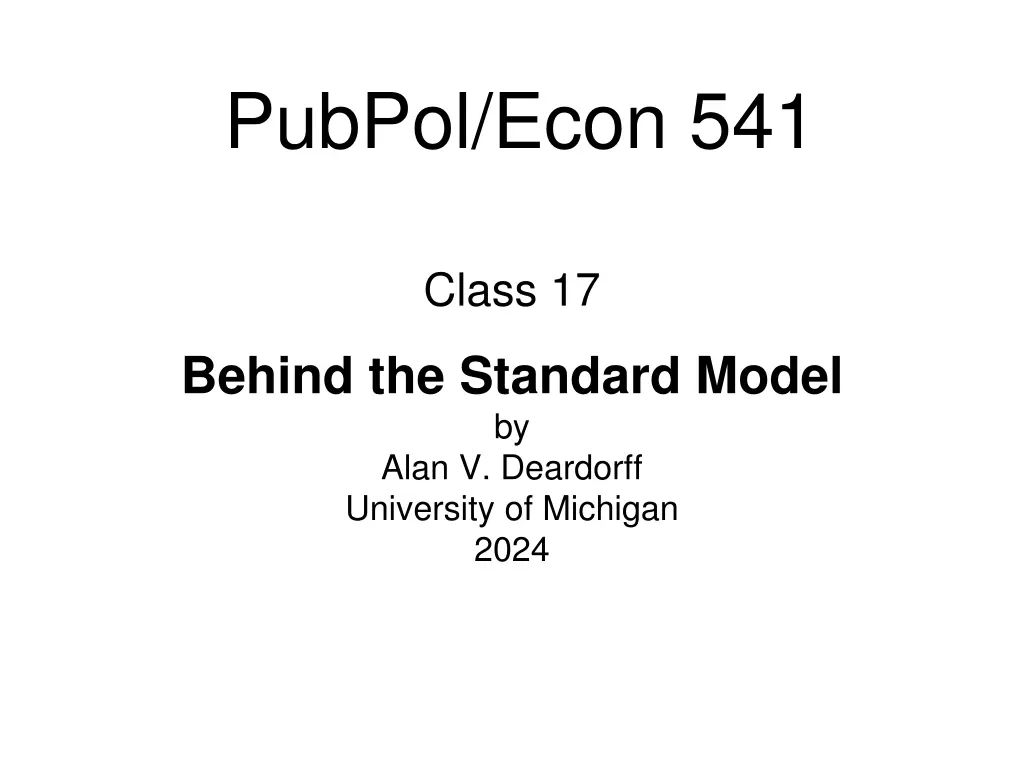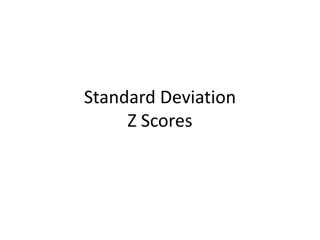
Understanding Trade Models Beyond the Standard Approach
Delve into the intricacies of trade models as explored in the class by Alan V. Deardorff at the University of Michigan, focusing on comparative advantage, trade impacts on economies like wages, and the implications of factors like labor mobility. Explore the Ricardian and Heckscher-Ohlin models and their relevance in shaping global trade dynamics.
Download Presentation

Please find below an Image/Link to download the presentation.
The content on the website is provided AS IS for your information and personal use only. It may not be sold, licensed, or shared on other websites without obtaining consent from the author. If you encounter any issues during the download, it is possible that the publisher has removed the file from their server.
You are allowed to download the files provided on this website for personal or commercial use, subject to the condition that they are used lawfully. All files are the property of their respective owners.
The content on the website is provided AS IS for your information and personal use only. It may not be sold, licensed, or shared on other websites without obtaining consent from the author.
E N D
Presentation Transcript
PubPol/Econ 541 Class 17 Behind the Standard Model by Alan V. Deardorff University of Michigan 2024
Quiz 7 Q5 9.08 6.92 8.06 9 7 10 10 8 4 Q6 Q7 Mean Median Max Min 8 9.5 6 Standard deviation 0.79 1.89 0.84 Class 17: Behind the Standard Model 2
Announcements Paper 2 Due in a week: Nov 6 Some points: I don t have correct numbers this time Use your judgement on what numbers to use Do assume Canada a small country Report results for all three years Supply elasticity: Your guess is good as mine (1) Do sensitivity analysis, especially on supply elasticity Class 17: Behind the Standard Model 3
Purpose Today To look behind the Production Possibilities of the Standard Model: QF QC Class 17: Behind the Standard Model 4
Purposes Why? 1. To see what determines Comparative Advantage and thus trade 2. To see how trade has affects inside economies, especially wages Class 17: Behind the Standard Model 5
Pause for Discussion Class 17: Behind the Standard Model 6
Questions on KOM To produce more of one good, the economy must sacrifice some production of another good. Is this always true? What if there is unemployment? Class 17: Behind the Standard Model 7
Outline Ricardian Model Comparative Advantage Heckscher-Ohlin Model Trade and Wages Class 17: Behind the Standard Model 8
Outline Ricardian Model Comparative Advantage Heckscher-Ohlin Model Trade and Wages Class 17: Behind the Standard Model 9
The Ricardian Model Implies that factors earn the same in both. Assumes Two goods: cloth C and food F Outputs: QF, QC Prices: PF, PC One factor: labor L Perfectly mobile between sectors Two countries: Home and Foreign (*) Takes as given Unit labor requirements: Fixed (they do not vary with output) Very important! aC, aF, aC*, aF* Class 17: Behind the Standard Model 10
Ricardian Technology Unit labor requirements ai, ai* = amount of labor needed to produce one unit of output of good i = C,F Assume (so that Home will end up exporting C, as we ll see below): aC aF aF* aC* < labor to produce cloth than food, compared to foreign (*) Class 17: Behind the Standard Model i.e., Home (without *) needs relatively less 11
Ricardian PPF QF Full employment requires L = aCQC + aFQF and thus, solving for QF: QF = L/aF (aC/aF)QC L/aF aC/aF L/aC QC Class 17: Behind the Standard Model 12
2-Countries PPFs QF QF* Assumes aC aF aC* aF* L*/aF* < L/aF aC*/aF* aC/aF L/aC QC L*/aC* QC* Class 17: Behind the Standard Model 13
NOT equilibrium: RP < aC/aF QF QF* QF* Both would produce only F RP < aC/aF L*/aF* L*/aF* L/aF aC*/aF* aC/aF L/aC QC L*/aC* QC* Class 17: Behind the Standard Model 14
NOT equilibrium: RP > aC*/aF* RP > aC*/aF* QF QF* Both would produce only C L*/aF* L/aF aC*/aF* aC/aF L/aC QC L*/aC* QC* Class 17: Behind the Standard Model 15
Specialized Equilibrium: aC/aF < RP < aC*/aF* QF* QF* aC/aF < RP < aC*/aF* QF Both specialize: Home in C, Foreign in F Trade S* L*/aF* L*/aF* RP D* L/aF D RP aC*/aF* aC/aF S L/aC QC L*/aC* QC* Class 17: Behind the Standard Model 16
Specialized Equilibrium: aC/aF < RP < aC*/aF* QF QF* QF* Gains from Trade aC/aF < RP < aC*/aF* S* L*/aF* L*/aF* RP D* L/aF D SA*=DA* SA=DA RP aC*/aF* aC/aF S L/aC QC L*/aC* QC* Class 17: Behind the Standard Model 17
Home-Diversified Equilibrium: aC/aF = RP < aC*/aF* QF QF* QF* aC/aF = RP < aC*/aF* Only Foreign specializes: Trade S* L*/aF* L*/aF* D* L/aF SA* =DA* SA=DA=D RP RP S aC*/aF* aC/aF L/aC QC L*/aC* QC* Class 17: Behind the Standard Model 18
Home Diversified Equilibrium: aC/aF = RP < aC*/aF* QF QF* QF* aC/aF = RP < aC*/aF* Only Foreign gains from trade S* L*/aF* L*/aF* D* L/aF SA* =DA* SA=DA=D RP RP S aC*/aF* aC/aF L/aC QC L*/aC* QC* Class 17: Behind the Standard Model 19
Effects of Trade in Ricardian Model Labor moves wholly or partially out of import-competing sector All labor paid the same wage (due to perfect mobility), so all share any gains from trade Real wage rises as price of import falls Note that transition, not modelled, could be painful Class 17: Behind the Standard Model 20
Pause for Discussion Class 17: Behind the Standard Model 21
Questions on KOM In the Ricardian Model, do both countries necessarily gain from trade? Is it possible for a country to lose from trade? What do the relative supply and demand curves of a country look like in the Ricardian Model, and why? What do they look like for the world of two countries? Class 17: Behind the Standard Model 22
QF Home QF* Foreign L*/aF* L/aF aC*/aF* aC/aF L/aC L*/aC* RP = PC/PF RP = PC/PF RP = PC/PF Home Foreign World RS* RS W aC*/aF* RS aC/aF RQ= QC/QF RQ= QC/QF RQ (L/aC )/(L*/aF*) Class 17: Behind the Standard Model 23
More Questions on KOM Suppose that preferences change so that, at given prices, demanders everywhere increase their preferred consumption of one good and decrease it for the other. In most models, such a change will cause both the price and the quantity of the preferred good to increase. Is that true in the Ricardian Model, of a closed economy and/or of a two-country world? Class 17: Behind the Standard Model 24
Outline Ricardian Model Comparative Advantage Heckscher-Ohlin Model Trade and Wages Class 17: Behind the Standard Model 25
Comparative Advantage Before Ricardo, we knew that if each country had absolute advantage in one good (Meaning they were better at producing it) Then they would export it But it was thought that, if one country had absolute advantage in both goods, then trade might be impossible or the disadvantaged country would lose from trade Class 17: Behind the Standard Model 26
Comparative Advantage Ricardo showed that this was wrong. What matters is comparative advantage A less productive country can still gain by exporting the good in which its disadvantage is relatively smaller & it will surely gain if prices change for it at all Class 17: Behind the Standard Model 27
Comparative Advantage Ricardo used numerical examples like the following, with unit labor requirements: Absolute advantage: Comparative advantage: Class 17: Behind the Standard Model 28
Comparative Advantage By assigning amounts of labor to the countries, one can show that each can consume more of both goods if US exports Food Other (UK or UC) exports Cloth UC has comparative advantage in Cloth because its relative labor cost is lower: 1 2=0.10 ?? ?? ??<?? ?? ??=0.02 0.20=?? 0.01= 2 ?? Class 17: Behind the Standard Model 29
Comparative Advantage Recall from Ricardian Model: QF QF* Assumes aC aF aC* aF* L*/aF* < Thus Home has comparative advantage in C L/aF aC*/aF* aC/aF L/aC QC L*/aC* QC* Class 17: Behind the Standard Model 30
Comparative Advantage In a much more general context than the Ricardian model, comparative advantage needs to be defined in terms of relative autarky prices. Why? Because costs vary along production possibility curve: QF QC Class 17: Behind the Standard Model 31
Comparative Advantage Relative autarky prices. Let ?? Then country ? has a comparative advantage in good ?1 relative to ?2, compared to another country ? , if ??1 ??2 ??2 ? be the autarky price of good ? in country ?. ? ?< ? ??1 ? Class 17: Behind the Standard Model 32
Pause for Discussion Class 17: Behind the Standard Model 33
Questions on KOM Does comparative advantage imply absolute advantage? Does absolute advantage imply comparative advantage? Class 17: Behind the Standard Model 34
Questions on Deardorff How can one identify comparative advantage in terms of Unit labor requirements for producing goods? Output per worker in producing the goods? Opportunity cost? Why is comparative advantage a relative concept in two senses simultaneously? Class 17: Behind the Standard Model 35
Questions on Deardorff When a high-wage country trades with a low-wage country in the Ricardian model, who is hurt, or hurt more: The high-wage workers or the low-wage workers? Class 17: Behind the Standard Model 36
Outline Ricardian Model Comparative Advantage Heckscher-Ohlin Model Trade and Wages Class 17: Behind the Standard Model 37
The Heckscher-Ohlin (H-O) Model Assumes Two goods: cloth C and food F Outputs: QF, QC Prices: PF, PC Class 17: Behind the Standard Model 38
The Heckscher-Ohlin (H-O) Model Again, very important! Assumes Two factors: labor L, land T Endowments: L, T, L*, T* Both are assumed perfectly mobile between industries Thus there is, within the country, a single wage, w, paid to labor, and rental, r, paid to land (If there weren t, then all would move to the sector paying more.) Class 17: Behind the Standard Model 39
The Heckscher-Ohlin (H-O) Model Assumes Two countries: Home and Foreign (*) Differ (only) in relative factor endowments Class 17: Behind the Standard Model 40
The Heckscher-Ohlin (H-O) Model Assumptions: Takes technologies as given Constant-returns-to-scale production functions Same in both countries Homothetic preferences are also the same in both countries, as in the Standard Model Class 17: Behind the Standard Model 41
H-O Technology Unit factor requirements aij = aij* = amount of factor i = L, T needed to produce one unit of output of good j = C,F (Usually, but not here, these are taken to be variable, depending on factor prices.) Assume (so that Home will end up exporting C, as we ll see below): aLC aTC aTF aLF > That is, production of cloth is labor-intensive relative to land, compared to production of food Class 17: Behind the Standard Model 42
H-O Endowments Factor endowments H-O takes as given the countries endowments of the two factors Assume (again so that Home will end up exporting C, as we ll see below): L T T* L* > That is, Home is relatively well-endowed with labor (relative to land, compared to Foreign) Class 17: Behind the Standard Model 43
H-O PPFs With these assumptions, it can be shown that PPFs are curved, as in the Standard Model. Home, because it is relatively well endowed with labor, is better able to produce the labor-intensive good C. PPFs therefore look as we saw them in the Standard Model. Class 17: Behind the Standard Model 44
H-O Trade Equilibrium QF* Foreign QF Home Trade S* D* D SA*=DA* SA=DA S QC* QC Class 17: Behind the Standard Model 45
H-O Gains from Trade QF* Foreign QF Home Gains from Trade S* D* D SA*=DA* SA=DA S QC* QC Class 17: Behind the Standard Model 46
H-O Production Changes Due to Trade QF* Home Foreign QF Home shifts towards C Foreign shifts towards F RPW S* RPA D* D SA*=DA* SA=DA RPW S RPA* QC* QC Class 17: Behind the Standard Model 47
H-O Price Changes Due to Trade QF* Home Foreign QF RP rises in Home and falls in Foreign RPW S* RPA D* D SA*=DA* SA=DA RPW S RPA* QC* QC Labor and land move from F to C Labor and land move from C to F Class 17: Behind the Standard Model 48
H-O Effects on Factor Prices Can t be seen in these pictures, but Factor Price Equalization (FPE) Equality of goods prices (due to free trade) causes equality of factor prices (wage of labor and rent of land) Stolper-Samuelson Theorem (SS) As price rises for good using intensively the abundant factor, Real wage or rent of that factor rises (in both sectors) Real wage or rent of other ( scarce ) factor falls (in both sectors) Class 17: Behind the Standard Model 49
Factor Price Equalization Simple analytics PC = waLC+ raTC PF = waLF+ raTF => w = (aTFPC aTCPF)/ r = (aLFPC aLCPF)/ where = aLCaTF aLFaTC Thus (FPE): If PC=PC* & PF=PF* Then w=w* & r=r* Class 17: Behind the Standard Model 50






















